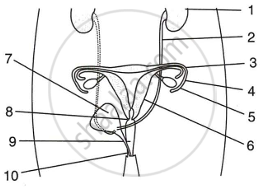Advertisements
Advertisements
प्रश्न
The diagram given below is that of a developing human foetus. Study the diagram and then answer the questions that follow:

(i) Label the parts numbered 1 to 3 in the diagram.
(ii) Mention any two functions of the part labelled 2 in the diagram.
(iii) Explain the significance of the part numbered 3 in the diagram.
(iv) Define the term ‘Gestation’. What is the normal gestational period of the developing human embryo?
(v) Mention the sex chromosomes in a male and female embryo.
उत्तर
(i)
- Umbilical cord
- Placenta
- Amniotic fluid
(ii) Functions of placenta:
- It allows the diffusion of oxygen, nutrients and immune products from the mother to the foetus.
- It allows the diffusion of waste material generated by the foetus to the mother to be excreted.
(iii)
- The amniotic fluid prevents the foetus from injury and shocks.
- It allows the foetus some amount of movement.
- It prevents the amnion from sticking to the foetus.
- It maintains an even pressure all around the foetus.
(iv) The time period required for the development of the foetus inside the uterus is called gestation. The normal gestation period in humans is 280 days (9 months).
(v) Male sex chromosomes: One ‘X’ chromosome and one ‘Y’ chromosome (XY) Female sex chromosomes: Two ‘X’ chromosomes (XX)
APPEARS IN
संबंधित प्रश्न
If a woman is using a copper-T, will it help in protecting her from sexually transmitted diseases?
What are the different methods of contraception?
The site of maturation of human sperms is the
Name the liquid that contains sperms.
What name is given to the fusion of sperm and ovum?
During adolescence, several changes occur in the human body. Mark one change from the following associated with sexual maturation in boys.
When a human female reaches a certain age then vaginal bleeding occurs for a few days after regular time intervals.
(a) What is this process known as (i) in scientific terms, and (ii) in everyday language?
(b) At what approximate age this process starts in human females? When is the human female said to have attained at this stage?
(c) After how much time is this process repeated? For how many days does this process usually last?
(d) What does the onset of this process in human females signify?
(e) At which particular event in the life of a human female does this process stop temporarily but start again?
(f) At which approximate age of human female does this process stop permanently?
Given below is a diagram of two systems together in the human body.
 |
- Name the systems.
- Name the parts numbered 1-10.
- Describe the functions of the parts 3, 4, 5 & 6.
- What will happen if the part 3 on both sides gets blocked?
Describe in brief the role of testis in human male reproductive system.
What is the composition of semen?
